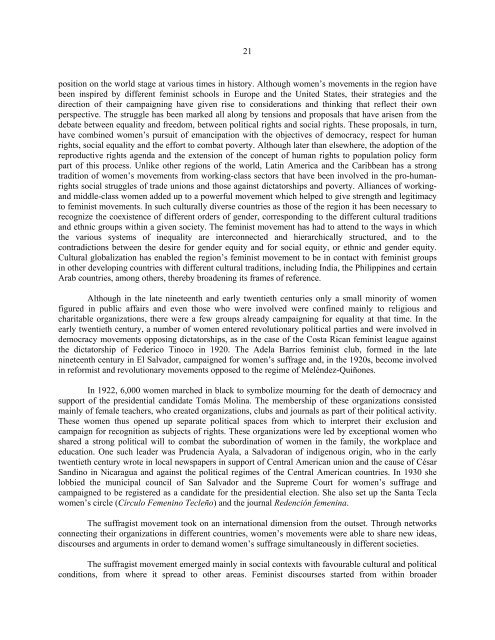Women in Latin America and the Caribbean - Cepal
Women in Latin America and the Caribbean - Cepal
Women in Latin America and the Caribbean - Cepal
Create successful ePaper yourself
Turn your PDF publications into a flip-book with our unique Google optimized e-Paper software.
21<br />
position on <strong>the</strong> world stage at various times <strong>in</strong> history. Although women’s movements <strong>in</strong> <strong>the</strong> region have<br />
been <strong>in</strong>spired by different fem<strong>in</strong>ist schools <strong>in</strong> Europe <strong>and</strong> <strong>the</strong> United States, <strong>the</strong>ir strategies <strong>and</strong> <strong>the</strong><br />
direction of <strong>the</strong>ir campaign<strong>in</strong>g have given rise to considerations <strong>and</strong> th<strong>in</strong>k<strong>in</strong>g that reflect <strong>the</strong>ir own<br />
perspective. The struggle has been marked all along by tensions <strong>and</strong> proposals that have arisen from <strong>the</strong><br />
debate between equality <strong>and</strong> freedom, between political rights <strong>and</strong> social rights. These proposals, <strong>in</strong> turn,<br />
have comb<strong>in</strong>ed women’s pursuit of emancipation with <strong>the</strong> objectives of democracy, respect for human<br />
rights, social equality <strong>and</strong> <strong>the</strong> effort to combat poverty. Although later than elsewhere, <strong>the</strong> adoption of <strong>the</strong><br />
reproductive rights agenda <strong>and</strong> <strong>the</strong> extension of <strong>the</strong> concept of human rights to population policy form<br />
part of this process. Unlike o<strong>the</strong>r regions of <strong>the</strong> world, Lat<strong>in</strong> <strong>America</strong> <strong>and</strong> <strong>the</strong> <strong>Caribbean</strong> has a strong<br />
tradition of women’s movements from work<strong>in</strong>g-class sectors that have been <strong>in</strong>volved <strong>in</strong> <strong>the</strong> pro-humanrights<br />
social struggles of trade unions <strong>and</strong> those aga<strong>in</strong>st dictatorships <strong>and</strong> poverty. Alliances of work<strong>in</strong>g<strong>and</strong><br />
middle-class women added up to a powerful movement which helped to give strength <strong>and</strong> legitimacy<br />
to fem<strong>in</strong>ist movements. In such culturally diverse countries as those of <strong>the</strong> region it has been necessary to<br />
recognize <strong>the</strong> coexistence of different orders of gender, correspond<strong>in</strong>g to <strong>the</strong> different cultural traditions<br />
<strong>and</strong> ethnic groups with<strong>in</strong> a given society. The fem<strong>in</strong>ist movement has had to attend to <strong>the</strong> ways <strong>in</strong> which<br />
<strong>the</strong> various systems of <strong>in</strong>equality are <strong>in</strong>terconnected <strong>and</strong> hierarchically structured, <strong>and</strong> to <strong>the</strong><br />
contradictions between <strong>the</strong> desire for gender equity <strong>and</strong> for social equity, or ethnic <strong>and</strong> gender equity.<br />
Cultural globalization has enabled <strong>the</strong> region’s fem<strong>in</strong>ist movement to be <strong>in</strong> contact with fem<strong>in</strong>ist groups<br />
<strong>in</strong> o<strong>the</strong>r develop<strong>in</strong>g countries with different cultural traditions, <strong>in</strong>clud<strong>in</strong>g India, <strong>the</strong> Philipp<strong>in</strong>es <strong>and</strong> certa<strong>in</strong><br />
Arab countries, among o<strong>the</strong>rs, <strong>the</strong>reby broaden<strong>in</strong>g its frames of reference.<br />
Although <strong>in</strong> <strong>the</strong> late n<strong>in</strong>eteenth <strong>and</strong> early twentieth centuries only a small m<strong>in</strong>ority of women<br />
figured <strong>in</strong> public affairs <strong>and</strong> even those who were <strong>in</strong>volved were conf<strong>in</strong>ed ma<strong>in</strong>ly to religious <strong>and</strong><br />
charitable organizations, <strong>the</strong>re were a few groups already campaign<strong>in</strong>g for equality at that time. In <strong>the</strong><br />
early twentieth century, a number of women entered revolutionary political parties <strong>and</strong> were <strong>in</strong>volved <strong>in</strong><br />
democracy movements oppos<strong>in</strong>g dictatorships, as <strong>in</strong> <strong>the</strong> case of <strong>the</strong> Costa Rican fem<strong>in</strong>ist league aga<strong>in</strong>st<br />
<strong>the</strong> dictatorship of Federico T<strong>in</strong>oco <strong>in</strong> 1920. The Adela Barrios fem<strong>in</strong>ist club, formed <strong>in</strong> <strong>the</strong> late<br />
n<strong>in</strong>eteenth century <strong>in</strong> El Salvador, campaigned for women’s suffrage <strong>and</strong>, <strong>in</strong> <strong>the</strong> 1920s, become <strong>in</strong>volved<br />
<strong>in</strong> reformist <strong>and</strong> revolutionary movements opposed to <strong>the</strong> regime of Meléndez-Quiñones.<br />
In 1922, 6,000 women marched <strong>in</strong> black to symbolize mourn<strong>in</strong>g for <strong>the</strong> death of democracy <strong>and</strong><br />
support of <strong>the</strong> presidential c<strong>and</strong>idate Tomás Mol<strong>in</strong>a. The membership of <strong>the</strong>se organizations consisted<br />
ma<strong>in</strong>ly of female teachers, who created organizations, clubs <strong>and</strong> journals as part of <strong>the</strong>ir political activity.<br />
These women thus opened up separate political spaces from which to <strong>in</strong>terpret <strong>the</strong>ir exclusion <strong>and</strong><br />
campaign for recognition as subjects of rights. These organizations were led by exceptional women who<br />
shared a strong political will to combat <strong>the</strong> subord<strong>in</strong>ation of women <strong>in</strong> <strong>the</strong> family, <strong>the</strong> workplace <strong>and</strong><br />
education. One such leader was Prudencia Ayala, a Salvadoran of <strong>in</strong>digenous orig<strong>in</strong>, who <strong>in</strong> <strong>the</strong> early<br />
twentieth century wrote <strong>in</strong> local newspapers <strong>in</strong> support of Central <strong>America</strong>n union <strong>and</strong> <strong>the</strong> cause of César<br />
S<strong>and</strong><strong>in</strong>o <strong>in</strong> Nicaragua <strong>and</strong> aga<strong>in</strong>st <strong>the</strong> political regimes of <strong>the</strong> Central <strong>America</strong>n countries. In 1930 she<br />
lobbied <strong>the</strong> municipal council of San Salvador <strong>and</strong> <strong>the</strong> Supreme Court for women’s suffrage <strong>and</strong><br />
campaigned to be registered as a c<strong>and</strong>idate for <strong>the</strong> presidential election. She also set up <strong>the</strong> Santa Tecla<br />
women’s circle (Círculo Femen<strong>in</strong>o Tecleño) <strong>and</strong> <strong>the</strong> journal Redención femen<strong>in</strong>a.<br />
The suffragist movement took on an <strong>in</strong>ternational dimension from <strong>the</strong> outset. Through networks<br />
connect<strong>in</strong>g <strong>the</strong>ir organizations <strong>in</strong> different countries, women’s movements were able to share new ideas,<br />
discourses <strong>and</strong> arguments <strong>in</strong> order to dem<strong>and</strong> women’s suffrage simultaneously <strong>in</strong> different societies.<br />
The suffragist movement emerged ma<strong>in</strong>ly <strong>in</strong> social contexts with favourable cultural <strong>and</strong> political<br />
conditions, from where it spread to o<strong>the</strong>r areas. Fem<strong>in</strong>ist discourses started from with<strong>in</strong> broader











